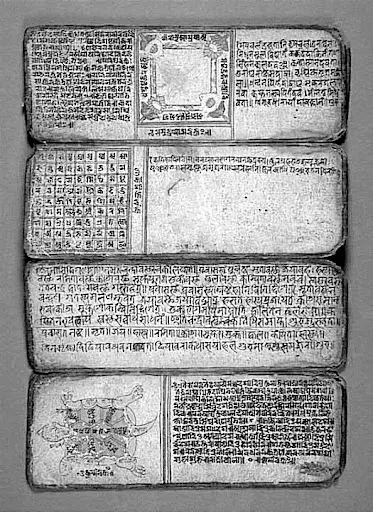We acquire knowledge about our past by historical sources, which are basically remains of past in the form of monuments, inscriptions, numismatics, pottery, tools, weapons, food grains, manuscripts, tablets, etc. Broadly, we divide historical sources into two categories as archaeological and literary sources. Both these historical sources, although divided into categories, have their unique identity and usage; we can’t neglect them in historical reconstruction and use them together. However, we found and accepted that archaeological sources are much reliable than literary sources.
 |
| 14th-15th Century Manuscripts on Astrology from Nepal. |
||| Learn about various Archaeological Dating
Method. |||
In history, literary source play
a important role in creating different account of events as they provide detailed
information which is not provided by archaeological sources; but important is
that, sources must be deciphered, so we can understand what it exactly mean. Without
decipherment of script, we cannot determined it’s degree of importance.
Harrapan Script is the best example of it, which is not deciphered yet. Sources
with deciphered scripts helps historians in assigning date, creating theories
and accounts of historical events like Rajatarangini written by Kalhan (1148AD)
tell us details about kings of Kashmir, on the basis of this masterpiece,
scholars reconstruction the history of Kashmir easily.
As discussed above, writing
can be in any symbolic form with a particular pattern and script, which used in
communication after arranging it in a specific form. However, today we have
digital gadgets for writing like personal computers, mobile phones, laptops,
tablets, etc. With the help of keyboard, stylus, etc. one can write or draw
whatever he or she want. These modern gadgets just make life easier and provide
an effective way of writing and learning. Even, we wrote this academic article
by using one of these gadgets and similarly you are reading it too by using
them. But, when we go back in past we found that people use palm leaves, birch
bark, sheep leather, wooden tablets, copper plates, stone tablets, etc. as material
on which they wrote. These materials are chosen on the basis of their long lasting shelf life, convenience of
writing on them and importantly for their purpose. Commonly birch bark and palm
leaves were used. One of the tool for writing was hand made ink (made by
mixture of lampblack and glue, etc.) and hand crafted stylus pen (mostly made
by reeds, bones and metals), and in this method, after one or two letters
writers need to dip again in inkpot. Other know method was carving and then
spreading ink on it to make it clearly visible.
||| Making of Palm Leaves
Manuscripts in Ancient Times. |||
We found a number of palm leaf and birch bark manuscripts in India which are very important and informative source. From these resources we are able to reconstruct history of India’s past. Apart from them various stone and copper plates were found, for example – Sohgaura copper plate (3rd century BC) of Maurya mention about famine relief efforts. Birch bark and palm leafs were mostly used and majority of the texts were written on them. Wooden tablets, stone tablets and copper plates were mostly used for specific writing like commemorate events, messages, grants, etc. It is also important to note that, although these tablets and plates are included in literary sources but they are as good as archaeological source in the form of inscriptions. Infect, all literary sources at their material level are archaeological one but when we talk about texts or their contents they are part of literary source. Later, we see invention of paper in 104 AD by Chinese court official Ts’ai Lun of Han Dynasty in Lei-Yang, China. It become prominent writing material with time. Soon, printing techniques were available and these advancements facilities more literary works for future generations. So, literary sources were now easily written off and available. And from them we are able to know a lot of details about our past.
As we know history is very
vast subject, for making it more meaningful, historians divided literary
sources into two broader categories, which are as follows:
1. Indigenous Texts
2. Foreign Texts
These two broader categories
will subdivided into two to four categories which will vary according to historian
and region as different geographical regions have their unique history and
similarly different historians have different views. We classify it into following
appropriate categories as:-
A. Religious Texts
B. Non-religious Texts
(i). Historical Texts
(ii). Semi-Historical Texts
(iii). Biographical Texts
Note 1. Harappan script was
earliest Indian script but not deciphered yet. When we deciphered it,
definitely we see a lot of changes in Indian history which definitely affect or
change World history too. This script contents pictographic letters, due to
this termed Pictographic Script. Mesopotamia and Egyptian civilizations were
contemporary to the Indus Valley Civilization.
Note 2. The earliest Indian
deciphered and best-known Brahmi inscriptions are the rock-cut edicts of Ashoka
in north-central India region dating
250–232 BCE.
Bibliography
1. AFANDPA. “The History of
Paper”. American Forest & Paper Association. July 9, 2021. United States of
America.
[https://www.afandpa.org/news/2021/history-paper#:~:text=Paper%20was%20first%20made%20in,to%20dry%20in%20the%20sun]
2. Al-Atabi, Akram Jabar. “What
is Writing”. Research Gate. June 2020. [https://www.researchgate.net/publication/341864922_What_is_Writing]
3. Cepi. “AD 105 China: birthplace of paper”.
CONFEDERATION OF EUROPEAN PAPER INDUSTRIES. Brussels, Belgium.
[https://www.cepi.org/ad-105-china-birthplace-of-paper/#:~:text=The%20birth%20of%20paper%2C%20as,with%20which%20to%20make%20paper]
[ISBN10: 9390113644 /ISBN13:
978-9390113644]
[ISBN-10: 048-5115476 /ISBN-13: 978-0485115476]
6. MOC. “Manuscripts”. Ministry
of Culture, Government of India. Culture. India.
[https://indiaculture.gov.in/manuscripts]
[ISBN10: 9788131716779 /ISBN-13: 978-8131716779]
[ISBN-10: 812-0803698 /ISBN-13: 978-8120803695]
See Also
1. Making of Palm Leaves
Manuscripts in Ancient Times.
2. Archaeological Dating Method.
3. Akhmim Wooden Tablet from
Ancient Egypt.
4. Negotiating with Historical Sources.
5. Invention of Printing in the World.
7. Primary, Secondary and Tertiary Sources of History.
8. Excavation and Exploration in Archaeological.
9. Evolution of Printing Industry in the World.
10. UGC NET JRF History Optional complete Notes on Latest Syllabus.




Good Research work.
ReplyDeleteGood post
ReplyDeleteExcellent 👌
ReplyDelete